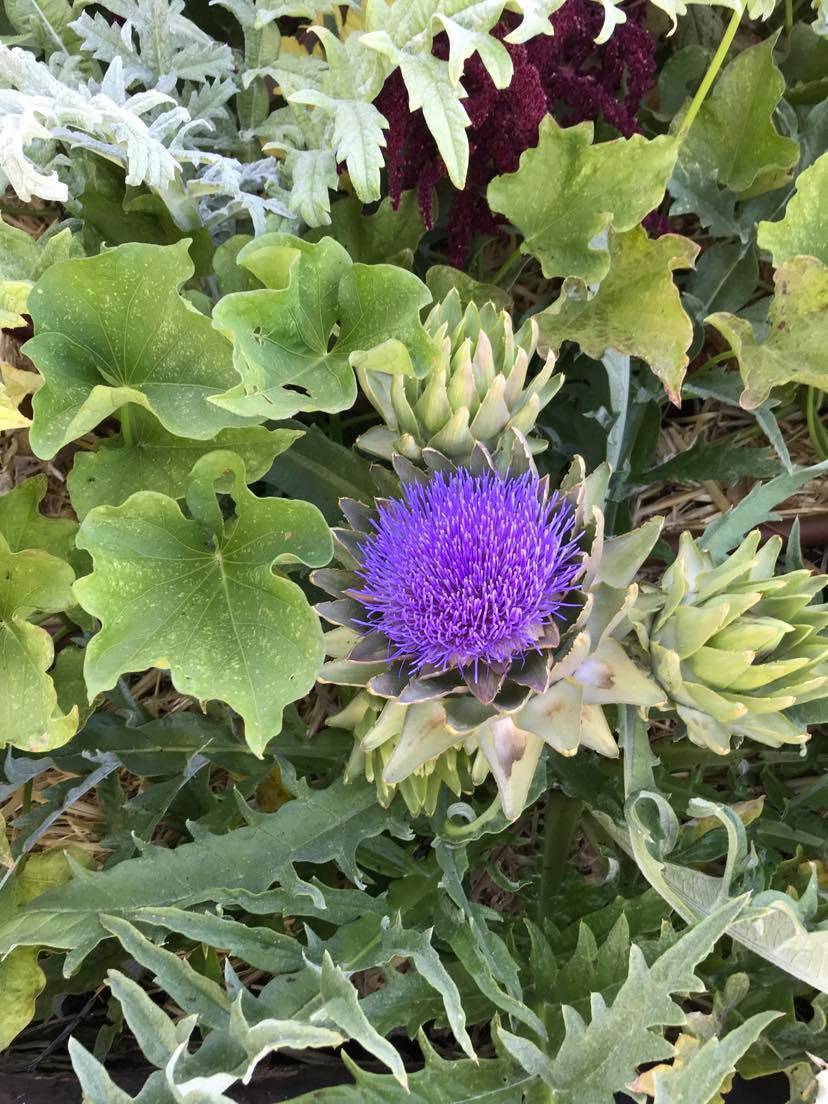In Season: Getting to the heart of the Artichoke
I’ve been harvesting artichokes for a few weeks now in my garden. They’re one of the first vegetables that I look forward to harvesting in the spring. These edible flower buds are not only delicious but also provide a brilliant purple thistle-like bloom when left to flower.
Artichokes are thought to have originated in the Mediterranean. They thrive in hot, dry climates, making it a perfect choice for our region.
How to plant and grow artichokes:
In our region, artichoke is a perennial. Once planted, your artichoke will produce spring through summer and return after winter. I buy artichokes as a start from a nursery rather than starting them from seed. It takes at least two years before you begin to see a harvest from artichokes so buying them already started will allow you to have a harvest in the first year you plant them.
The drawback to buying starts is there is not a lot of variety available. Of the choices available from our local nurseries, the variety that has done the best for me is “Green Globe”.
Artichokes can be planted in late fall or early spring. I generally plant them in mid-to-late March. Choose a space where you can plant artichokes at least 4 feet apart. They grow very large can grow up to 5 feet wide and 6 feet tall.
Artichokes prefer well-drained soil. I have raised beds that are dedicated to perennials where I plant mine. They also prefer full sun but can tolerate afternoon shade.
To plant, dig your planting hole as deep as the pot the artichoke is already in and twice as wide in circumference. Amend the planting hole with a fertilizer. I use worm casings or compost before planting. After you transplant the artichoke, give it a good soaking and cover the soil with mulch.
Artichokes need to be watered deeply and frequently. In my garden they are on the same drip system as the rest of the vegetables I grow. The dripper is set to automatically turn on twice a day for 10 minutes when it is less than 90 degrees and three times a day for 10 minutes when it is over 90 degrees.
Artichokes are a heavy feeder. I give my artichoke plants a nice dose of compost tea every two weeks from spring through summer.Check your plants daily for signs of trouble and treat the issues as soon as you see them. One common problem I have noticed with artichokes in my garden is spider mites. The leaves will turn yellow and dry up and I will often see what appears to be a spider web spread across the leaves. I have also had issues with aphids on the artichoke leaves in early spring.
The remedy for both problems is simply giving the leaves a good blast with the hose. This may need to be repeated a several times over the course of a few days to get rid of the pests. Be sure you also spray the underside of the leaves where the aphids and spider mites like to hide. Ladybugs are a good solution as well and I find that I often see an onset of ladybugs before I notice the damages from the pests. You can also purchase ladybugs at local nurseries. Damaged leaves should be removed from the plant.
One way to help prevent pests in the first place is to trim off all the lower leaves that touch the ground. This will make it harder for pest to climb onto the plant from the soil. This will also help to prevent soil-borne diseases.
When to harvest your artichokes:
I typically see the first buds in my garden sometime in late April to early May. The center bud will form first. I prefer to harvest the bud when the bracts open just slightly.
To harvest, simply cut the stem just below the two leaves that the bud sits above. This part of the stem is also edible and nearly as tender as the cherished artichoke heart.
Side shoots will start to grow and within a few days you should start to see other buds forming. These side buds will likely be smaller than the main bud but are also generally more tender when cooking. You should continue to see production until late fall.
Overwintering artichokes:
After your final harvest of artichokes in the fall you will need to ready the plant for winter. To do this, cut the stem to the base at the ground and then cover with 4 to 6 inches of mulch.
If you have deciduous trees on your property you should have plenty of leaves to use at this point of the year.
Sometime after the third year your artichokes will need to be divided. You will notice that new shoots spring up around the base of the plant. These can be dug up and planted elsewhere.
Perennial vegetables like artichokes are a great investment for your garden. Once established, they will provide you with a yield for several years and are generally a low-maintenance crop. A few hours of work per year is all the time you will need to devote to them. This will free up some of your time to dedicate to the more demanding fruits of the summer season, like tomatoes.
Terri Meehan is the Founder of Southern Nevada Gardening Association a regional group. She is a garden mentor and local farmer in Pahrump. Send questions or comments to her at sonvgarden@gmail.com














